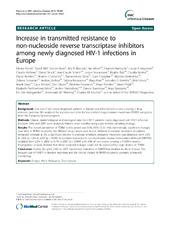Increase in transmitted resistance to non-nucleoside reverse transcriptase inhibitors among newly diagnosed HIV-1 infections in Europe
Frentz, Dineke; Van de Vijver, David A. M. C.; Abecasis, Ana B.; Albert, Jan; Hamouda, Osamah; Jørgensen, Louise B.; Kücherer, Claudia; Struck, Daniel; Schmit, Jean-Claude; Vercauteren, Jurgen; Åsjø, Birgitta; Balotta, Claudia; Beshkov, Danail; Camacho, Ricardo J.; Clotet, Bonaventura; Coughlan, Suzie; Griskevicius, Algirdas; Grossman, Zehava; Horban, Andrzej; Kolupajeva, Tatjana; Korn, Klaus; Kostrikis, Leondios G.; Liitsola, Kirsi; Linka, Marek; Nielsen, Claus; Otelea, Dan; Paraskevis, Dimitrios; Paredes, Roger; Poljak, Mario; Puchhammer-Stöckl, Elisabeth; Sönnerborg, Anders; Stanekova, Danica; Stanojevic, Maja; Van Wijngaerden, Eric; Wensing, Annemarie M. J.; Boucher, Charles A. B.; on behalf of the SPREAD Programme
Peer reviewed, Journal article
Published version
Permanent lenke
https://hdl.handle.net/1956/8424Utgivelsesdato
2014-07-21Metadata
Vis full innførselSamlinger
Originalversjon
https://doi.org/10.1186/1471-2334-14-407Sammendrag
Background: One out of ten newly diagnosed patients in Europe was infected with a virus carrying a drug resistant mutation. We analysed the patterns over time for transmitted drug resistance mutations (TDRM) using data from the European Spread program. Methods: Clinical, epidemiological and virological data from 4317 patients newly diagnosed with HIV-1 infection between 2002 and 2007 were analysed. Patients were enrolled using a pre-defined sampling strategy. Results: The overall prevalence of TDRM in this period was 8.9% (95% CI: 8.1-9.8). Interestingly, significant changes over time in TDRM caused by the different drug classes were found. Whereas nucleoside resistance mutations remained constant at 5%, a significant decline in protease inhibitors resistance mutations was observed, from 3.9% in 2002 to 1.6% in 2007 (p = 0.001). In contrast, resistance to non-nucleoside reverse transcriptase inhibitors (NNRTIs) doubled from 2.0% in 2002 to 4.1% in 2007 (p = 0.004) with 58% of viral strains carrying a K103N mutation. Phylogenetic analysis showed that these temporal changes could not be explained by large clusters of TDRM. Conclusion: During the years 2002 to 2007 transmitted resistance to NNRTI has doubled to 4% in Europe. The frequent use of NNRTI in first-line regimens and the clinical impact of NNRTI mutations warrants continued monitoring.
Utgiver
BioMed CentralTidsskrift
BMC Infectious DiseasesOpphavsrett
Copyright 2014 Frentz et al.; licensee BioMed Central Ltd.Dineke Frentz et al.; licensee BioMed Central Ltd.

